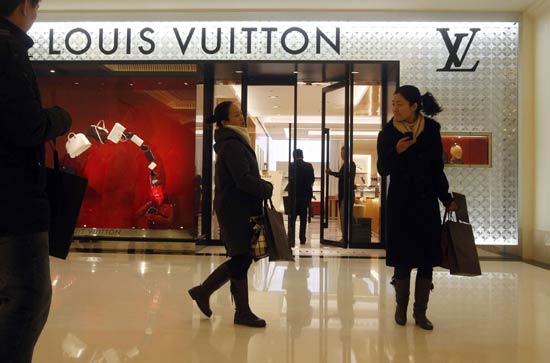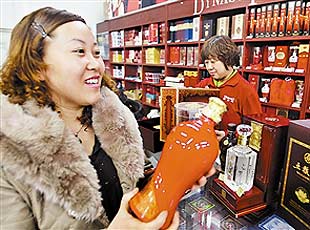Luxury brands need a change of approach
China Daily, February 28, 2014 Adjust font size:
There can be no doubt that the luxury market in China has been experiencing a tough winter, nor that the government's anti-corruption and frugality campaign has been a major factor in this, nor that it will continue to be a drag on the market's growth in 2014.
 |
|
There can be no doubt that the luxury market in China has been experiencing a tough winter, nor that the government's anti-corruption and frugality campaign has been a major factor in this, nor that it will continue to be a drag on the market's growth in 2014. [Photo/China Daily] |
Growth in luxury spending on the Chinese mainland is expected to have cooled to just 2 percent in 2013, down from 7 percent the year before and a staggering 30 percent in 2011, according to Bain and Co's annual China's Luxury Goods Market Study published at the end of 2013.
Although Chinese consumers are still the biggest consumers of luxury goods worldwide - they accounted for 29 percent of the global market last year - it is reported that Chinese shoppers now do two-thirds of their luxury shopping abroad, which has triggered slowdowns in store traffic and store openings domestically. Therefore, in order to survive in China, luxury brands need to change their strategy to adapt to the shrinking demand in China.
No more rapid expansion should be the first principle for luxury brands, as expanding the number of stores is no longer enough to drive growth.
Of the 20 luxury brands included in Bain's study, the number of new openings in China declined from 150 in 2012 to 100 last year. Most brands are now focusing on renovation, relocation and operational improvements for domestic customers, said Bruno Lannes, a Bain partner in Greater China.
For example, Bentley, one of the top English luxury car brands, does not plan to add any new cities to its dealer network as its sales revenue in China declined by 3 percent in 2013. Despite the fact, the brand's global sales were up 19 percent.
"China's luxury market has quickly changed from land-grab to a steady focus on consumer experience and 'like-for-like' sales," Lannes said.
Another characteristic of the market for luxury goods in China is that demand is now polarizing at the highest and lowest ends of brands' range. Take handbags, for example, 25 percent of handbag sales were for models priced at less than 5,000 yuan ($819), while 33 percent was for bags costing more than 20,000 yuan.
So the second principle for luxury brands to realize their development is providing more affordable luxury goods.
One successful brand focusing on "affordable luxury" is Coach, which concentrates on leather products with an average price of $300 per piece. The US brand raked in more than $5 billion in annual sales in the fiercely competitive luxury market even during the recession days. For many young Chinese consumers, affordable luxury is a lifestyle choice that combines both fashionable design and good quality. Kate Spade, another American example of "affordable luxury", plans to focus on meeting the demands of the emerging middle class in China.
Even top luxury brands, such as Chanel, Armani and Cartier, are adopting the "affordable luxury" principle and providing more lower price products for Chinese consumers. Small accessories, such as key rings and scarves, have proved very popular in the Chinese market.
Since gift buying has been hit by the government's anti-corruption and frugality campaign, it is no longer a major reason for luxury purchases in China. What luxury brands should follow in the domestic market is aligning their product lines to meet consumers' real expectations and purchasing power.
The last principle is they need to "embrace the Internet". Marketing and sales channels are changing rapidly. Chinese shoppers are extremely tech-savvy and well-informed. According to Bain's findings, 73 percent of consumers in China use the Internet to get information about luxury goods purchases before they buy.
Nearly 60 percent of consumers have made at least some luxury purchases through parallel channels known as "daigou" (via overseas contacts, via Taobao, or via other professional buyer agencies and websites) rather than from brands or department stores. Half of those who have not purchased this way would consider doing so in the future.
Therefore, luxury brands also need to be tech-savvy if they are to succeed in the Chinese market. One brand that has successfully positioned itself in China as a premium lifestyle product is Apple, and its strategy was put clearly in the spotlight in October when Angela Ahrendts, then-CEO of Burberry, joined the high-tech giant. Ahrendts doubled the stock price of Burberry during the eight years she was in change of the well-known British brand. In an online video called Burberry's Social Story, Angela announced with her iPhone: "This is the entrance to our brand."
Other luxury brands should take note of Ahrendts' move and prepare for the digital luxury age; otherwise, they will risk losing their market share in China quickly.
Until recently, luxury brands were showing their best performance in decades thanks to Chinese consumers. However, they are going to have to work harder if they want to continue winning the consumers' favor.


